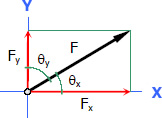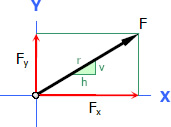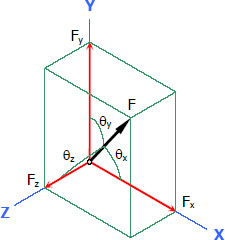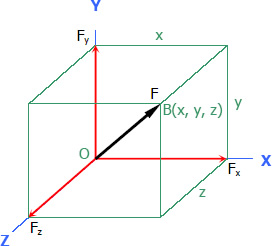Components of a Force
Forces acting at some angle from the the coordinate axes can be resolved into mutually perpendicular forces called components. The component of a force parallel to the x-axis is called the x-component, parallel to y-axis the y-component, and so on.
Components of a Force in XY Plane

$F_x = F \cos \theta_x = F \sin \theta_y$
$F_y = F \sin \theta_x = F \cos \theta_y$
$F= \sqrt{{F_x}^2 + {F_y}^2}$
$\tan \theta_x = \dfrac{F_y}{F_x}$
Given the slope of the line of action of the force as v/h

$r =\sqrt{h^2 + v^2}$
$F_x = F (h/r)$
$F_y = F (v/r)$
Components of a Force in 3D Space

Given the direction cosines of the force:
$F_x = F \cos \theta_x$
$F_y = F \cos \theta_y$
$F_z = F \cos \theta_z$
$F = \sqrt{{F_x}^2 + {F_y}^2 + {F_z}^2}$
$\cos \theta_x = \dfrac{F_x}{F}$
$\cos \theta_y = \dfrac{F_y}{F}$
$\cos \theta_z = \dfrac{F_z}{F}$
Given the coordinates of any two points along the line of action of the force (with reference to the figure shown, one of the points is the origin):

Let d = distance OB
$d = \sqrt{x^2 + y^2 + z^2}$
$F_x = F (x/d)$
$F_y = F (y/d)$
$F_z = F (z/d)$
Vector Notation of a Force (Rectangular Representation of a Force)
Where λ is a unit vector. There are two cases in determining λ; by direction cosines and by the coordinates of any two points on the line of action of the force.
Given the direction cosines:
${\bf \lambda} = \cos \theta_x {\bf i} + \cos \theta_y {\bf j} + \cos \theta_z {\bf k}$
Given any two points P1(x1, y1, z1) and P2(x2, y2, z2) on the line of action of the force:
${\bf \lambda} = \dfrac{1}{d} \left( d_x{\bf i} + d_y {\bf j} + d_z {\bf k} \right)$
Where
i, j, and k are unit vectors in the direction of x, y and z respectively.
$d_x = x_2 - x_1$
$d_y = y_2 - y_1$
$d_z = z_2 - z_1$
$d = \sqrt{{d_x}^2 + {d_y}^2 + {d_z}^2}$
$\cos \theta_x = d_x / d$
$\cos \theta_y = d_y / d$
$\cos \theta_z = d_z / d$
Note:
$\cos^2 \theta_x + \cos^2 \theta_y + \cos^2 \theta_z = 1$
$(d_x / d)^2 + (d_y / d)^2 + (d_z / d)^2 = 1$
Also note the following:
$F_x = \cos \theta_x = d_x / d$
$F_y = \cos \theta_y = d_y / d$
$F_z = \cos \theta_z = d_z / d$
$F = \sqrt{{F_x}^2 + {F_y}^2 + {F_z}^2}$
Thus,
${\bf F} = \dfrac{F}{d} \left( d_x{\bf i} + d_y {\bf j} + d_z {\bf k} \right)$
In simplest term
The above rectangular representation of a force is applicable in both 2D and 3D forces.
- Log in to post comments
